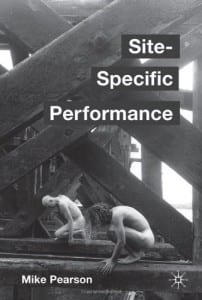 (Image Credit: http://www.palgrave.com/page/detail/sitespecific-performance-mike-pearson/?K=9780230576704)
(Image Credit: http://www.palgrave.com/page/detail/sitespecific-performance-mike-pearson/?K=9780230576704)
I had put off writing this entry for a long time as I wished to have time to really fortify my understanding of site-specific performance, and with the performance looming I believe I’ve finally had enough time to understand what I need to understand to create something unique to my site.
Site-specific performance is a myriad of things. It is “performance conceived on the basis of place in the real world” (Pavis, 1998, p. 337), which “places the audience at an entirely different relationship to the text, the place and the purpose for being there” (ibid, p. 338). It is the “articulate [exchange] between the work of art and the places in which its meanings are defined” (Kaye, 2000, p. 1). Site-specific performance can interact “with site as symbol, site as storyteller, site as structure” (Wilkie, 2002, p. 158). The practice can reveal layers within the site, giving it the potential “to explore spatial and material histories and to mediate the complex identities these histories remember and produce” (Harvie, 2005, p. 44)
So what does this mean to me? The use of exploring spatial and material histories makes site-specific performance a potent tool to recall and establish identities that are heavily linked to their own materiality and spatiality, e.g. gender, class, race, occupation. I believe this capability makes site-specific performance far more able to effect the people of a specific community/area than traditional theatre.
Site-specific performance is also excellent at engaging with an audience or participants, as they are often local to the site, and therefore implicated in the history you may be exploring. When you criticise or celebrate a site or institution via performance, the site’s connection to the invested local audience can create a far more compelling performance than one which holds only tenuous links to all participants. This personal investment of the audience in the site can cause tension between performer and audience, if a slanderous history in an exalted site is explored.
In the context of the museum which we are performing in, we had major decisions to consider in what way we would perform the site. Whether our performance would be “site-sympathetic” (Wilkie, 2002, 150) – an existing text physicalised in a specific site, site-generic (ibid) – performance which is created for a number of similar sites, or site-specific (ibid) – performance created for one specific site only. My performance is a critique of museums as an institute, classifying it as site-generic performance.
This understanding of what site-specific performance can do informs my creative process immensely, and although there is so much more to the definition of site-specific performance, these basic points are some most relevant to myself.
Works Cited:
Pavis, P. (1998) Dictionary of the Theatre: Terms, Concepts and Analysis. Toronto: University of Toronto Press.
Wilkie, F. (2002) Mapping the Terrain: A Survey of Site-Specific Performance in Britain. New Theatre Quarterly, 18 (2) pp. 150-158
Kaye, N. (2000) Site-Specific Art: Performance, Place and Documentation. London: Routledge.
Harvie, J. (2005) Staging the UK. Manchester: Manchester University Press.
Recent Comments